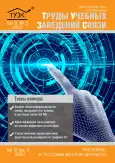Location Aware Beamforming in Millimeter-Wave Band Ultra-Dense Radio Access Networks. Part 2. Model of a Set of Radio Links
- Authors: Fokin G.A.1
-
Affiliations:
- The Bonch-Bruevich Saint Petersburg State University of Telecommunications
- Issue: Vol 9, No 5 (2023)
- Pages: 43-64
- Section: Articles
- URL: https://journals.rcsi.science/1813-324X/article/view/254396
- ID: 254396
Cite item
Full Text
Abstract
About the authors
G. A. Fokin
The Bonch-Bruevich Saint Petersburg State University of Telecommunications
Email: fokin.ga@sut.ru
ORCID iD: 0000-0002-5358-1895
SPIN-code: 4922-4442
References
- Фокин Г.А. Диаграммообразование на основе позиционирования в сверхплотных сетях радиодоступа миллиметрового диапазона. Часть 1. Модель двух радиолиний // Труды учебных заведений связи. 2023. Т. 9. № 4. С. 44‒63. doi: 10.31854/1813-324X-2023-9-4-44-63
- Фокин Г.А. Концепция диаграммообразования на основе позиционирования в сетях 5G // Вестник связи. 2022. № 10. С. 1‒7.
- Фокин Г.А. Сценарии позиционирования в сетях 5G // Вестник связи. 2020. № 3. С. 13‒21.
- Фокин Г.А. Моделирование сверхплотных сетей радиодоступа 5G с диаграммообразованием // T-Comm: Телекоммуникации и транспорт. 2021. Т. 15. № 5. С. 4‒21. doi: 10.36724/2072-8735-2021-15-5-4-21.
- Фокин Г.А. Модели диаграммообразования в сверхплотных сетях радиодоступа 5G. Часть 1. Оценка помех // Первая миля. 2021. № 3(95). С. 66‒73. doi: 10.22184/2070-8963.2021.95.3.66.73
- Фокин Г.А. Модели диаграммообразования в сверхплотных сетях радиодоступа 5G. Часть 2. Оценка разноса устройств // Первая миля. 2021. № 4(96). С. 66‒73. doi: 10.22184/2070-8963.2021.96.4.66.72
- Фокин Г.А. Процедуры выравнивания лучей устройств 5G NR // Электросвязь. 2022. № 2. С. 26‒31. DOI:10.34832/ ELSV.2022.27.2.003
- Фокин Г.А. Модели управления лучом в сетях 5G NR. Часть 1. Выравнивание лучей при установлении соединения // Первая миля. 2022. № 1(101). С. 42‒49. doi: 10.22184/2070-8963.2022.101.1.42.49
- Фокин Г. Модели управления лучом в сетях 5G NR. Часть 2. Выравнивание лучей при ведении радиосвязи // Первая миля. 2022. № 3(103). С. 62‒69. doi: 10.22184/2070-8963.2022.103.3.62.68
- Fazliu Z.L., Malandrino F., Chiasserini C.F., Nordio A. MmWave Beam Management in Urban Vehicular Networks // IEEE Systems Journal. 2021. Vol. 15. Iss. 2. PP. 2798‒2809. doi: 10.1109/JSYST.2020.2996909
- Andrews J.G., Zhang X., Durgin G.D., Gupta A.K. Are we approaching the fundamental limits of wireless network densification? // IEEE Communications Magazine. 2016. Vol. 54. Iss. 10. PP. 184‒190. doi: 10.1109/MCOM.2016.7588290
- Roh W., Seol J.-Y., Park J., Lee B., Lee J., Kim Y., et al. Millimeter-wave beamforming as an enabling technology for 5G cellular communications: theoretical feasibility and prototype results // IEEE Communications Magazine. 2014. Vol. 52. Iss. 2. PP. 106‒113. doi: 10.1109/MCOM.2014.6736750
- Chiaraviglio L., Turco S., Bianchi G., Blefari-Melazzi N. “Cellular Network Densification Increases Radio-Frequency Pol-lution”: True or False? // IEEE Transactions on Wireless Communications. 2022. Vol. 21. Iss. 4. PP. 2608‒2622. doi: 10.1109/TWC.2021.3114198
- Chiaraviglio L., Rossetti S., Saida S., Bartoletti S., Blefari-Melazzi N. “Pencil Beamforming Increases Human Exposure to ElectroMagnetic Fields”: True or False? // IEEE Access. 2021. Vol. 9. PP. 25158‒25171. doi: 10.1109/ACCESS.2021.3057237
- Thors B., Furuskär A., Colombi D., Törnevik C. Time-Averaged Realistic Maximum Power Levels for the Assessment of Radio Frequency Exposure for 5G Radio Base Stations Using Massive MIMO // IEEE Access. 2017. Vol. 5. PP. 19711‒19719. doi: 10.1109/ACCESS.2017.2753459
- Awada A., Lobinger A., Enqvist A., Talukdar A., Viering I. A simplified deterministic channel model for user mobility investigations in 5G networks // Proceedings of the International Conference on Communications (ICC, Paris, France, 21‒25 May 2017). IEEE, 2017. doi: 10.1109/ICC.2017.7997079
- Ali A., Karabulut U., Awada A., Viering I., Tirkkonen O., Barreto A.N., et al. System Model for Average Downlink SINR in 5G Multi-Beam Networks // Proceedings of the 30th Annual International Symposium on Personal, Indoor and Mobile Radio Communications (PIMRC, Istanbul, Turkey, 08‒11 September 2019). IEEE, 2019. PP. 1‒6. doi: 10.1109/PIMRC.2019.8904367
- Yu B., Yang L., Ishii H. Load Balancing With 3-D Beamforming in Macro-Assisted Small Cell Architecture // IEEE Transactions on Wireless Communications. 2016. Vol. 15. Iss. 8. PP. 5626‒5636. doi: 10.1109/TWC.2016.2563430
- Harada H., Prasad R. Simulation and Software Radio for Mobile Communications. Artech House, 2002. 448 p.
- ITU-R M.2135-1 (12/2009) Guidelines for evaluation of radio interface technologies for IMT-Advanced.
- ITU-R M.2412-0 (10/2017) Guidelines for evaluation of radio interface technologies for IMT-2020.
- GPP TS 23.273 V18.2.0 (06/2023) 5G System (5GS) Location Services (LCS); Stage 2 (Release 18).
- GPP TS 22.071 V17.0.0 (03/2022) Location Services (LCS); Service description; Stage 1 (Release 17).
- GPP TS 23.032 V18.0.0 (06/2023) Universal Geographical Area Description (GAD) (Release 18).
- GPP TS 22.261 V19.3.0 (06/2023) Service requirements for the 5G system; Stage 1 (Release 19).
- Gross F. Smart Antennas for Wireless Communications: With MATLAB. McGraw-Hill Professional, 2005. 288 p.
- Balanis C.A. Antenna theory: analysis and design. John Wiley & Sons, 2016. 1104 p.
- Mailloux R.J. Phased Array Antenna Handbook. Artech House, 2017. 691 p.
- Hamdy M.N. Beamformers Explained. URL: www.commscope.com/globalassets/digizuite/542044-beamformer-explained-wp-114491-en.pdf (дата обращения 18.10.2023)
- HBR 3.5 GHz 8x8 MIMO Panel Antenna. URL: https://halberdbastion.com/products/antenna-catalogue/hbr-35-ghz-8x8-mimo-panel-antenna (дата обращения 18.10.2023)
- GPP TR 38.901 V17.0.0 (03/2022) Study on channel model for frequencies from 0.5 to 100 GHz (Release 17).
- Имитационная модель совокупности радиолиний с диаграммообразованием на основе позиционирования в сетях 5G // GitHub. URL: https://github.com/grihafokin/LAB_system_level_rus (дата обращения 18.10.2023)
- polyshape. 2-D polygonal shapes // MathWorks. URL: https://www.mathworks.com/help/matlab/ref/polyshape.html (дата обращения 18.10.2023)
- subtract. Difference of two polyshape objects // MathWorks. URL: https://www.mathworks.com/help/matlab/ref/polyshape.subtract.html (дата обращения 18.10.2023)
Supplementary files






